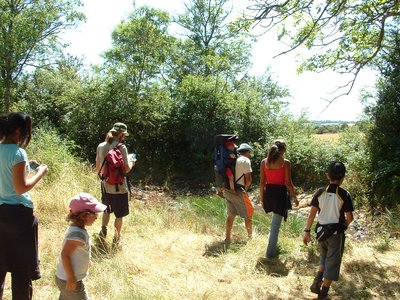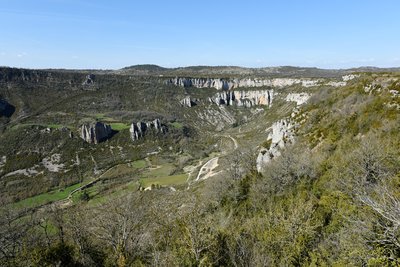
Tournemire hiking circuit
Starting from Tournemire, walk across a majestic setting made of limestone rocks and grey marls and try to identify bird and butterfly species that have found refuge in the area - the Rock Swallow, the Red-billed Chough, the Large Blue – and plant species clinging to the cliffs such as Hormathophylla macrocarpa... A walk through a haven of biodiversirty!
6 points of interest

Entrée du tunnel de Tournemire - (c) Joël Atché  Geology
GeologyTournemire tunnel
This 1885 m long old railway tunnel was excavated towards the end of the 19th century. In 1988, a laboratory designed to undertake, geophysical, geomechanical and hydrochemistry studies was set up inside the tunnel. The aim of this fundamental research, carried out by the Nuclear Safety and Protection Institute, is to gain more knowledge of the way underground water moves and transports dissolved materials. It also examines the geological structure of the area. Some grey marine marl outcrops can be seen in the surroundings and are an equal mixture of clay and limestone.
To get more information: IRSN
Causse du Larzac (La Rouquette) - (c) Delphine Atché  Agropastoralism
AgropastoralismDry Grasslands
Dry Grasslands which are iconic features of the caussenard landscape originate from pristine forests that have been transformed by human actions (land clearing, stubble-burning, farming and pasture). This ecosystem is a semi-natural environment with outstanding biological particularities: it provides a critical habitat for rare animal and plant species and is a perfect hunting ground for birds nesting in surrounding cliffs and gorges. Moreover, these traditional pastoral lands have been used for centuries. At the end of the spring season, the causses scenery is decked out with tall grass (feather grass) that forms the shape of a thick silver hair. (source PNR Grands Causses).

Lavogne en terre - DelphineAtche  Agropastoralism
AgropastoralismLavogne
Ever since the Neolithic period, humans have kept on improving the numerous natural ponds that they came across all around the Causse. They took advantage of these small land depressions called sotch or doline that provided essential water supplies to ensure the sheep watering, but were also used as laundry places or fish ponds, although their clayey bottom have always posed problems with leakage.
In the Occitan language, the word lavanha refers to all kinds of ponds whether natural or hand built, whereas at the PNRGC, we have chosen to keep the word lavogne, or lavagne to designate ponds with paved bottoms, for they have witnessed the development of pastoralism over the 19th century. (source PNR Grands Causses).

Le cirque de Tournemire - Claude Chambaud  Geology
GeologyThe Tournemire cirque
Situated in the southwest of the Larzac Causse, the Tournemire Cirque is a remarkable geological area marking the bondary beetwen the fore-causses and the great causses. It presents limestone ledges and rocky escarpments with caves and cavities where raptors such as the eagle owl and the golden eagle nest.
Le cirque de Tournemire - Roquefort Tourisme  Geology
GeologyTournemire amphitheatre
The great Tournemire amphitheatre is one of the most outstanding escarpments of the western edge of the Larzac and as such is classified "Zone Natura 2000". The lower slopes are the only part where Toarcian marls are visible in the SW erosion gullies, everywhere else these marls are hidden under rocky slopes and big rock slides. At the top of the slopes, the dolomitic limestone ruin-shaped cliffs frame the outline of this amphitheatre.
Martinet à ventre blanc - Jjacques Patricia -LPO  Fauna
FaunaBirds
The cliffs of the Tournemire amphitheatre are an important playground and nesting area for numerous birds. These cliffs are home to great variety of bird life, from the most expressive to the most secretive such as: the Rock Swallow; the Alpine Swift; the Red-billed Chough; the Wall creeper; Bats (Greater Horseshoe) and birds of prey nesting on cliffs among which is the Eurasian Eagle-Owl.
Description
- Starting from the car park at the Tournemire town hall, walk along the D23 towards Roquefort. 20 m before the passageway that goes under the railway, take the tarmac track on your right up to the old railway tunnel entrance. Follow the yellow marks and turn to the right on a footpath. Go through a fence, then after 100 m cross a path and keep following the ascending track opposite “the engineer trail”. Once you’ve reached the top of a steep slope, turn into a small dry canyon and after 150 m enjoy a magnificent view on your left. Keep going until you reach the Causse du Larzac where the Fournials fortified farm can be seen (private property, visits not allowed).
- Leaving the Fournials farm on your left, take the track to the right towards the Viala du Pas de Jaux. From here, a possible option is to walk onwards for 300 m and just before a small stone building leave the track and take right a footpath that goes directly down to Tournemire.
- Keep following the caussenard footpath and walk past a lavogne (natural pond with a paved bottom on your left) then carry on along the amphitheatre up to the Grépounac cross.
- Retrace your steps back to the fork with the Arnals path.
- Take left the track with a red and white marking (GR71C). Carry on the GR which goes down the Tournemire amphitheatre. Walk your way down to the Pont du Diable where you will see the brook Brias resurgence.
- Head back to Tournemire on the trail, then onto a road which passes the side of the stadium (on the right hand side) then past a beautiful building which was formerly a convent, come back to the Town Hall car park.
- Departure : Town Hall car park situated in the village centre, avenue Hippolyte Puech, in Tournemire.
- Arrival : Town Hall car park situated in the village centre, avenue Hippolyte Puech, in Tournemire.
- Towns crossed : Tournemire, Roquefort-sur-Soulzon, Saint-Rome-de-Cernon, and Viala-du-Pas-de-Jaux
Altimetric profile
Recommandations
Travel by bus or train: http://www.mobimipy.fr/
Carpooling : BlaBlaCar, Rézo Pouce, Covoiturage-libre, Idvroom, LaRoueVerte, Roulez malinInformation desks
Avenue de Lauras, 12250 Roquefort/Soulzon
Situated in the Grands Causses Regional Natural Park, the cheese village of Roquefort stretches on the hillside over the famous scree of the Combalou Rock, in southern Larzac. The village is at an elevation of 630 m and has 700 inhabitants.
OPENING PERIODS:
The Tourist Office is open all year round:
- In July and August, Monday to Saturday: 9.30 to 18.30, Sunday: 10.00 to 17.00.
- April, May, June, September, October; Monday to Saturday: 9.30 to 12.15 & 13.00 to 17.30, closed on Sunday.
- January, February, November, December; Monday to Friday: 9.30 to 12.15 & 13.00 to 17.00, closed on Saturday and Sunday.
Transport
Travel by bus or train: https://lio.laregion.fr/
Carpooling : BlaBlaCar, Rézo Pouce, Mobicoop, Idvroom, LaRoueVerte, Roulez malin
Access and parking
Coming from Saint-Affrique or from Millau, take the D999, then follow the D23 towards Tournemire for 6 km
Parking :
Accessibility
Source

Report a problem or an error
If you have found an error on this page or if you have noticed any problems during your hike, please report them to us here:

